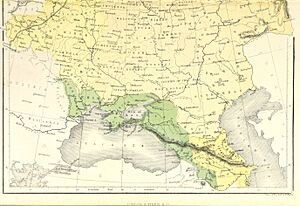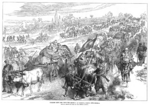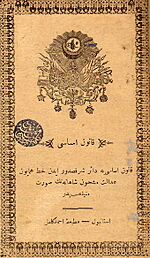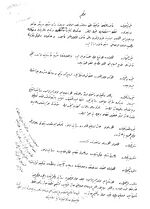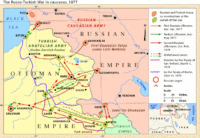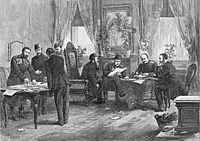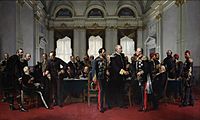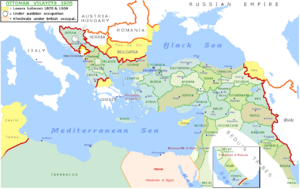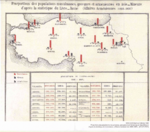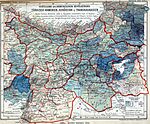Decline and modernization of the Ottoman Empire facts for kids
The Ottoman Empire was a huge and powerful empire that lasted for hundreds of years. But by the late 1700s, it started facing big challenges. Strong European countries were growing and becoming more modern. To keep up, the Ottoman Empire began a period of major changes and reforms. This time of change was called the Tanzimat, and it helped the empire become stronger in some ways.
Sultan Selim III started these changes with something called the Nizam-I Cedid (New Order). Later, important decrees like the Hatt-ı Şerif of Gülhane in 1839 and the Hatt-ı Hümayun in 1856 pushed these reforms further. Throughout the 1800s, the Ottoman government became more organized and had more control over its people than ever before.
However, even with these efforts, the empire struggled with the rise of nationalism. People in different parts of the empire, especially in the Balkan region, wanted their own independent countries. Many revolts and wars broke out. Also, Russia, France, and Britain kept taking Ottoman lands. This led to the empire steadily losing territory throughout the 1800s and early 1900s. By 1908, the Ottoman military was much more modern, like armies in Western Europe. Still, these challenges eventually led to the defeat and dissolution of the Ottoman Empire between 1908 and 1922.
Contents
Key Challenges of the Era
The 1800s saw a huge wave of nationalism spread across the world, and it greatly impacted the Ottoman Empire. People started feeling a strong connection to their own ethnic groups and wanted to form their own nations. This idea of national identity was new to the empire and caused many problems. Secret groups that later became political parties grew rapidly. Uprisings within Ottoman lands had major effects and shaped the empire's policies in the early 1900s. Some leaders wondered if the government's policies were to blame for these conflicts. While the empire had some successes, its ability to stop these ethnic uprisings was often questioned.
Russia also played a big role in this century. Russia often supported the independence of former Ottoman provinces, especially those with Slavic populations in the Balkans. By the end of the century, Romania, Serbia, and Montenegro gained independence, and Bulgaria became self-governing. This worried other major European powers. After the Congress of Berlin in 1878, Russia's expansion was limited, especially regarding Bulgaria.
The Ottoman military was strong until the late 1700s, when it suffered a big defeat against Russia in the 1768-74 war. Sultan Selim III tried to reform the military in 1789 but failed. Later, Sultan Mahmud II took over in 1808. He worked to strengthen the central government and famously got rid of the Janissaries, an old military group, in 1826 during an event called the Auspicious Incident. After this, efforts for a new, modern military system began.
The Ottoman Empire faced economic problems too. Historians like Paul Bairoch suggest that free trade policies hurt local industries. Unlike countries like China or Japan, the Ottoman Empire had very open trade, allowing many foreign goods to come in. This policy started with old agreements called capitulations, which lowered taxes on imports and exports. While some British economists praised this, others, like Prime Minister Benjamin Disraeli, criticized it. He said that free trade in Turkey had "destroyed some of the finest manufactures in the world."
The Ottoman public debt became a huge issue. The empire had never taken foreign loans before. But during the Crimean War in 1854, it borrowed money for the first time. The debt quickly grew, becoming larger than any other European nation's. After an economic downturn in 1873 and bad harvests, the Ottomans couldn't repay their loans and stopped payments in 1875. This made European countries, whose citizens had lent the money, very angry. This led to the creation of the Ottoman Public Debt Administration in 1881. This was a special group, mostly controlled by Europeans, whose only job was to collect taxes in the Ottoman Empire to pay back the European lenders. This debt was a heavy burden on the empire.
The period of stagnation and reform of the Ottoman Empire (1683–1827) ended with the breakup of the old Ottoman army. The main goal during the decline and modernization (1828–1908) was to create a strong military that could protect the empire. This took many sultans and many changes. By 1908, the Ottoman military had become modern and professional, similar to European armies.
Modernization Efforts (1808–1839)
Sultan Mahmud II (1808–1839)
Mahmud II inherited many problems. He faced challenges from Russia, England, and France, as well as military issues with the rebellious Janissaries. He also dealt with internal conflicts involving groups like Egyptians, Serbians, and Greeks. Rebellious governors also caused administrative problems.
Mahmud understood the state's growing difficulties and worked to fix them. For example, he reduced the power of local governors. He also regularly attended the state council, called the Divan, setting an example for reform. This was important because sultans had stopped attending the Divan centuries earlier, which was seen as a reason for the empire's decline. Mahmud II also improved how religious properties (Vakifs) were managed, putting their income under state control.
Serbian Independence (1810s)
In 1804, the Serbian Revolution against Ottoman rule began in the Balkans. By 1817, when the revolution ended, Serbia became a self-governing area, though still officially part of the Ottoman Empire. In 1821, Greece became the first Balkan country to gain full independence from the Ottomans. This was officially recognized in 1829 after the Greek War of Independence.
Greek War for Freedom (1820s)
In 1814, a secret group called the Filiki Eteria was formed to free Greece. They planned revolts in different areas. The first revolt started in March 1821. Soon after, the Maniots declared war, starting wider revolutionary actions. By October 1821, Greek fighters captured Tripolitsa, and other revolts spread.
However, different Greek groups started fighting among themselves, leading to civil wars. Muhammad Ali sent his son Ibrahim Pasha with an army to help the Ottomans stop the revolt. By late 1825, much of Greece was under Egyptian control. But Russia, Britain, and France decided to help Greece. Their navies destroyed the Ottoman-Egyptian fleet in the Battle of Navarino in 1827. With the help of a French army, Greece gained its freedom by 1828.
The Greek War of Independence showed how the idea of nationalism was spreading. It challenged the Ottoman system where people were grouped by religion, not by nationality.
The Auspicious Incident (1826)
Mahmud II's biggest achievement was getting rid of the Janissary corps in 1826. He wanted a modern army. Mahmud II cleverly provoked the Janissaries into revolting. He announced he was forming a new army trained like European forces. As he expected, they rebelled and marched on his palace. In the fighting, the Janissary barracks were burned by artillery fire, killing thousands. The survivors were exiled or executed. This event is known as the Auspicious Incident. This marked the start of major modernization, bringing European-style clothing, buildings, laws, and organization to the empire.
War with Russia (1828–1829)
The Russo-Turkish War of 1828–1829 happened before Mahmud could fully organize his new army. He had to use young, untrained soldiers against experienced Russian troops. The war ended badly for the Ottomans with the Treaty of Adrianople. Even though the reforms were meant for the military, they led to the creation of new schools teaching subjects like math and medicine to train new officers.
Conflicts with Egypt (1830s)
Later in his rule, Mahmud had problems with Muhammad Ali, the ruler of Egypt and Sudan. Muhammad Ali was technically Mahmud's subject but acted independently. Mahmud had asked for Muhammad Ali's help in Greece but hadn't paid him as promised. In 1831, Muhammad Ali declared war and took control of Syria and Arabia. In 1839, Mahmud tried to get his lands back, but his army was defeated by Muhammad Ali's son, Ibrahim Pasha, at Nezib. Mahmud II died shortly after hearing the news.
Economy and Taxes
The empire's finances were in bad shape, and some people were burdened by heavy taxes. Mahmud II worked to improve this. In 1834, he stopped public officials from taking extra money from people when traveling through provinces. He also said that money should only be collected twice a year. He declared that these unfair actions were against God's will and his own orders.
The haraç, a tax on non-Muslims, had been misused by collectors. The 1834 order changed how it was collected, making it fairer. Many other financial improvements were made. The government was simplified, and many unnecessary jobs were removed. Sultan Mahmud II set an example by being sensible and economical, organizing the royal household, and getting rid of paid officials who had no real duties.
Tanzimat Era (1839–1876)
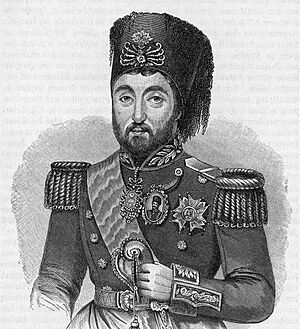
In 1839, the Hatt-i Sharif proclamation started the Tanzimat period. Tanzimat means "organization" in Arabic. Before these reforms, the government could take the property of anyone banished or sentenced to death, which encouraged cruelty. The new rules stopped governors from instantly sentencing people to death. Now, judges had to give a legal sentence.
The Tanzimat reforms did not stop nationalism in the Danubian Principalities and Serbia, which had been partly independent for a long time. In 1875, Serbia, Montenegro, and the combined areas of Wallachia and Moldavia declared full independence. After the Russo-Turkish War (1877–1878), the empire officially granted independence to these nations. Bulgaria also gained almost full independence.
The government's reforms led to a modern army, new banking systems, and the replacement of religious laws with secular (non-religious) laws. Old-fashioned guilds were replaced with modern factories.
Sultan Abdülmecit I (1839–1861)
Changes in the 1840s
The Ottoman Ministry of Post was created in Istanbul in 1840. The first post office opened that year. The empire also introduced its first paper banknotes in 1840. The finance system and legal codes were reorganized based on the French model. In 1841, the Meclis-i Maarif-i Umumiye was set up, which was an early version of the Ottoman Parliament.
The army was reorganized, and a regular way of recruiting soldiers and fixing their service time was introduced (1843–44). The empire adopted an Ottoman national anthem and national flag in 1844. A Council of Public Instruction was set up in 1845, followed by the Ministry of Education in 1847. Slavery and the slave trade were abolished in 1847. The first modern universities and teacher schools were established in 1848.
Samuel Morse received his first patent for the telegraph in 1847 from Sultan Abdülmecid himself, who tested the invention. Soon after, the first telegraph line was installed between Istanbul and other cities.
Identity Cards and Census (1844)
The Ottoman Empire had population records before the 1830s, but in 1831, a special office for population registers was created. In 1839, this office became more spread out to collect better data. Officials were appointed to different areas to record births and deaths. These records counted only male family members, noting their age, job, and property.
The first nationwide Ottoman census was in 1844. The first national identity cards, called Mecidiye or informally kafa kağıdı (head paper), were also introduced.
Reforms in the 1850s
In 1856, the Hatt-ı Hümayun promised equal rights for all Ottoman citizens, no matter their background or religion. This expanded on the 1839 Hatt-ı Şerif. The Tanzimat reforms had a big impact. Many future leaders, including Mustafa Kemal Atatürk (who founded the Republic of Turkey), were educated in schools set up during this period. These reforms guaranteed safety for people's lives, honor, and property.
Other changes included:
- Establishing the Ministry of Healthcare (1850).
- Creating the Commerce and Trade Code (1850).
- Setting up the Academy of Sciences (1851).
- Starting the Şirket-i Hayriye, which ran the first steam-powered ferries (1851).
- Creating the first European-style courts (1853).
- Establishing the modern Municipality of Istanbul (1854).
- Abolishing the capitation tax on non-Muslims and setting up a fair tax collection system (1856).
- Allowing non-Muslims to become soldiers (1856).
- Building the first telegraph networks (1847–1855) and railways (1856).
- Replacing guilds with factories.
- Establishing the Ottoman Central Bank (1856) and the Ottoman Stock Exchange (1866).
- Creating the Land Code (1857).
- Allowing private publishers and printing firms (1857).
- Establishing the School of Economical and Political Sciences (1859).
By 1855, the Ottoman telegraph network was working, and a Telegraph Administration was set up.
Crimean War (1853–1856)
The Crimean War (1853–1856) was a conflict between major European powers. Britain and France helped the Ottoman Empire defend itself against Russia. Most of the fighting happened in Russia's Crimean Peninsula. This was one of the first "modern" wars, using new technologies like railways and the telegraph. The Treaty of Paris (1856) that ended the war helped the Ottomans keep control of the Balkan Peninsula and the Black Sea area. This lasted until the Russo-Turkish War (1877–1878).
The Ottoman Empire took its first foreign loans in August 1854, soon after the Crimean War began. The war also caused many Crimean Tatars and Circassians to move from their homelands to the Ottoman Empire. By the early 1900s, many people in Turkey's cities were descendants of Muslim refugees from Russia and other lost Ottoman lands.
Armenian Nationalism (1860s)
Influenced by new ideas and the rise of nationalism, the Armenian national liberation movement began in the early 1860s. Armenian leaders and groups wanted to protect the Armenian population in the eastern Ottoman Empire. Their ultimate goal was to create an Armenian state in areas where Armenians lived.
Sultan Abdülaziz (1861–1876)
Abdülaziz continued the Tanzimat reforms. New administrative regions were set up in 1864, and a Council of State was created in 1868. Public education was organized like the French system, and Istanbul University was modernized in 1861. Abdülaziz was also the first sultan to travel outside his empire, visiting the United Kingdom in 1867. New rules for the press and journalism were introduced in 1864. In 1868, homosexuality was decriminalized.
Christian groups within the empire gained more rights, such as in the Armenian National Constitution of 1863. This constitution was written by Armenian thinkers and approved by the government. Christians in the empire, who often had higher education levels, started to do better economically than the Muslim majority. For example, in 1911, most wholesale companies in Istanbul were owned by ethnic Greeks.
In 1871, the Ministry of Post and the Telegraph Administration merged. By 1881, the first telephone line in Istanbul was set up. In 1909, the first manual telephone exchange began operating in the Grand Post Office.
Bulgarian Nationalism (1870s)
The national awakening of Bulgaria led to a revival movement. Unlike Greece and Serbia, the Bulgarian nationalist movement didn't immediately focus on armed resistance. After the Bulgarian Exarchate was established in 1870, a larger armed struggle began in the early 1870s. This struggle reached its peak with the April Uprising of 1876. The harsh way the uprising was put down by Ottoman soldiers increased the Bulgarian desire for independence.
Albanian Nationalism (1870s)
Nationalism developed later among Albanians compared to other Balkan groups. This was partly because most Albanians shared religious ties with the ruling Ottomans. Only from the 1870s did a "national awakening" movement grow among them. The Russo-Turkish War (1877–1878) greatly weakened Ottoman power in the Balkans. Albanians feared their lands would be divided among Montenegro, Serbia, Bulgaria, and Greece. This fear fueled the rise of Albanian nationalism.
Debt Crisis
After its first loan, the empire took out many more loans almost every year between 1858 and 1874. But economic problems grew. The Panic of 1873 hurt the economy, and there were bad harvests. Political issues also distracted leaders from the debt crisis. Finally, on October 6, 1875, the empire stopped paying interest on its loans and officially defaulted on October 30. The amount owed was huge, much larger than the empire's total income.
European nations, especially Britain and France, were outraged because their citizens held most of the loans. Their combined efforts led to the creation of the Ottoman Public Debt Administration in 1881. This organization acted as an independent part of the Ottoman government. Its main goal was to collect tax revenue to send back to the European lenders. Other nations like Germany, Italy, and Austria were also involved. The Ottoman debt became a heavy burden on the empire and added to other crises in the 1870s.
Ottoman Constitution (1876)
The reform period reached its peak with the Kanûn-u Esâsî (meaning "Basic Law"), which was announced on November 23, 1876. This constitution was written by a group of reformers called the Young Ottomans. It declared freedom of belief and equality for all citizens before the law.
The empire's First Constitutional Era was short-lived. The Young Ottomans, many educated in the West, believed a constitutional monarchy would solve the empire's growing problems. Through a military coup in 1876, they forced Sultan Abdülaziz to step down. Murad V became sultan, but he was ill and was removed after only a few months. His successor, Abdülhamid II (1876–1909), agreed to become a constitutional monarch, which he did on November 23, 1876. However, he suspended the parliament after only two years. When forced to bring it back, he abolished it instead. This ended the effectiveness of the constitution.
Sultan Murad V (1876)
After Abdülaziz was removed, Murad V became sultan. People hoped he would sign the constitution. However, due to health issues, Murad was also removed after just 93 days. He was the shortest-reigning sultan of the empire.
First Constitutional Era (1876–1878)
The First Constitutional Era of the Ottoman Empire was a brief period of constitutional monarchy. It began with the announcement of the Kanûn-ı Esâsî (meaning "Basic Law"), which was written by members of the Young Ottomans, on November 23, 1876. It ended on February 13, 1878, when Sultan Abdülhamid II suspended the Ottoman parliament.
Sultan Abdul Hamid II (1876–1878)
Russo-Turkish War (1877–1878)
The Russo-Turkish War of 1877–1878 was caused by rising nationalism in the Balkans and Russia's desire to regain lost territory and influence. As a result of this war, Romania, Serbia, and Montenegro officially declared independence from the Ottoman Empire. After nearly 500 years of Ottoman rule, the Bulgarian state was reestablished as the Principality of Bulgaria. The Congress of Berlin also allowed Austria-Hungary to occupy Bosnia and Herzegovina and Great Britain to take over Cyprus. Russia annexed some southern territories.
Congress of Berlin (1878)
The Congress of Berlin (June 13 – July 13, 1878) was a meeting of Europe's major powers and the Ottoman Empire. After Russia's victory in the Russo-Turkish War (1877–1878), there was an urgent need to stabilize the Balkans and create new nations. German Chancellor Otto von Bismarck led the Congress. He aimed to adjust borders to prevent major wars, recognize the Ottomans' reduced power, and balance the interests of the great powers.
As a result, Ottoman lands in Europe shrank greatly. Bulgaria became an independent principality within the Ottoman Empire, but it lost some of its territory. Romania gained full independence, but gave up some land to Russia. Serbia and Montenegro also gained complete independence, but with smaller territories.
In 1878, Austria-Hungary occupied the Ottoman provinces of Bosnia and Herzegovina and Novi Pazar. The Ottomans protested, and their troops remained in these areas for 30 years. In 1908, Austria annexed Bosnia-Herzegovina but withdrew from Novi Pazar to avoid war.
In exchange for British Prime Minister Benjamin Disraeli's support for the Ottomans at the Congress, Britain took control of Cyprus in 1878. Britain later sent troops to Egypt in 1882, effectively gaining control there. France occupied Tunisia in 1881.
The results of the Congress were initially seen as a success for peace. However, most participants were not fully satisfied, and their complaints eventually led to world war in 1914. Serbia, Bulgaria, and Greece gained less than they wanted. The Ottoman Empire, called the "sick man of Europe," was humiliated and weakened. Russia, despite winning the war, felt humiliated at Berlin. Tensions between Russia and Austria-Hungary grew, as did nationalistic feelings in the Balkans.
The Congress did keep Istanbul in Ottoman hands. It effectively reversed Russia's victory. The Congress of Berlin returned territories to the Ottoman Empire that had been given to Bulgaria, especially Macedonia. This led to Bulgaria wanting revenge, which contributed to the First Balkan War in 1912. As the Ottoman Empire shrank, many Balkan Muslims moved to the empire's remaining lands or to Anatolia. By 1923, only Anatolia and eastern Thrace remained as Muslim lands.
İstibdat Era (1878–1908)
The reign of Abdul Hamid II was sometimes called istibdad (despotism). His rule dealt with the results of 75 years of change and a reaction against those changes. He focused on making the empire more centralized. Local provinces had more control than the central government, and Abdul Hamid II wanted to change that.
His foreign policy was one of "non-commitment." He understood the Ottoman military was weak and the empire had little control at home. He tried to promote Pan-Islamism, a movement to unite Muslims, hoping it would give the empire a new identity. However, this was mostly unsuccessful because of the large non-Muslim population and European influence. His policies largely isolated the empire, which contributed to its decline. Many reformers who wanted a new constitution had to flee to Europe. New radical groups also began to threaten the empire's power.
Sultan Abdul Hamid II (1878–1908)
British Control in Egypt (1880s)
After gaining some self-rule in the early 1800s, Egypt faced political unrest by the 1880s. In April 1882, British and French warships arrived in Alexandria to support the local ruler and prevent anti-European groups from taking over.
In August 1882, British forces invaded and occupied Egypt, saying they were bringing order. The British supported the ruler, Khedive Tewfiq, and restored stability, which helped British and French financial interests. Egypt and Sudan remained officially Ottoman provinces until 1914. That year, the Ottoman Empire joined the Central Powers in World War I. Britain then officially annexed these two provinces and Cyprus.
Ottoman Census (1893–96)
In 1867, the Council of States began creating population records, making them more accurate. New ways of counting the population were introduced in 1874. This led to the creation of a General Population Administration in 1881-1882.
The first official census (1881–93) took 10 years to complete. The results were compiled in 1893. This was the first modern, general census done not for taxes or military purposes, but to gather information about the population. People were divided by ethnic and religious groups and gender. Numbers for both males and females were given for Muslims, Greeks, Armenians, Bulgarians, Catholics, Jews, Protestants, and others.
Armenian Issues (1890s)
Even though Armenians had their own constitution and national assembly from the Tanzimat reforms, they tried to demand that the Ottoman government follow Article 61 of the Treaty of Berlin (1878), which promised reforms for Armenians.
Kurdish Groups and Conflicts
In the 1880s, some Kurdish families opposed the empire, wanting more independence. Shaykh Ubayd Allah of Nihri tried to create an "independent Kurd principality" around the Ottoman-Persian border, where many Armenians lived. He gathered 20,000 fighters, but his men lacked discipline and looted villages. Shaykh Ubayd Allah was captured in 1882, and his movement ended.
The Bashkaleh clash in May 1889 was a violent encounter between the Armenakan Party and the Ottomans. This event was important because Armenian newspapers reported that documents showed a large plot for a national movement. Ottoman officials believed these men were part of a big revolutionary group. This led to more armed conflicts. The Gugunian Expedition in 1890 was an attempt by Armenian nationalists from Russian Armenia to cross the border into the Ottoman Empire to support local Armenians.
The Kum Kapu demonstration happened in the Armenian quarter of Kum Kapu in Istanbul. On July 27, 1890, some Armenian activists interrupted a church service to read a statement. They criticized the Armenian patriarch and national assembly for not focusing on national politics. They tried to force the patriarch to join a march to the Yıldız Palace to demand the implementation of Article 61 of the Treaty of Berlin. This event led to violence, but many Armenians found safety in Muslim parts of the city.
Hamidiye Cavalry
Kurdish groups sometimes looted towns and villages. In 1892, Sultan Abdul Hamid II created the Hamidiye light cavalry, an organized Kurdish force. One reason was to counter the Russian threat. However, scholars believe the main reason was to suppress Armenian nationalist revolutionaries. These revolutionaries were seen as a threat who might work with the Russians. The Hamidiye corps were well-armed, irregular cavalry units, mostly Kurdish, operating in the eastern provinces. They were meant to patrol the border and prevent cooperation between Kurds and Armenians.
However, the Hamidiye units often remained loyal to their tribes rather than the Sultan. They quickly realized they were immune to civil law and could only be tried by military courts. This led them to act like "legalized robber brigades," stealing grain, taking fields, and robbing shopkeepers. Some argue that creating the Hamidiye made the conflict with Armenians worse. Kurdish leaders also taxed the local population to support these units, which Armenians saw as exploitation. This caused more tension between the two groups. The Hamidiye cavalry often harassed and assaulted Armenians.
In 1908, after the Sultan was overthrown, the Hamidiye Cavalry was officially disbanded. However, since they were tribal forces before, they continued to act as such afterward. The Hamidiye Cavalry is often seen as a military failure because it contributed to tribal conflicts.
Armenian Resistance
The Hamidiye regiments were often linked to the Hamidian massacres of 1894-96, especially during the violent suppression in Sasun (1894). In July 1897, the Khanasor Expedition was launched against the Kurdish Mazrik tribe, who were part of the Hamidiye cavalry. The first major battle in the Armenian resistance took place in Sassoun, where Armenian activists encouraged resistance. The Armenian Revolutionary Federation also helped arm the local people. The Armenians of Sassoun fought the Ottoman army and Kurdish irregulars but were outnumbered. This was followed by the Zeitun Rebellion (1895–1896), where activists encouraged resistance in other areas.
In these regions, a kind of civil war between Armenians and Muslims (including the Hamidiye cavalry) lasted for months. It ended through mediation by the Great Powers. However, instead of Armenian self-rule, Kurdish tribal chiefs kept much of their power. Sultan Abdulhamid did little to change the traditional power structure of Kurdish societies. Because of their remote, mountainous location and limited transportation, the government had little control over these provinces. It had to make informal agreements with tribal chiefs, who often had more authority than government officials.
The 1896 Ottoman Bank takeover was carried out by an Armenian group who attacked the Ottoman Bank in Istanbul. The takeover lasted 14 hours, resulting in deaths of some Armenian attackers and Ottoman soldiers. The Ottoman response led to more violence against Armenians in Constantinople. Sultan Abdul Hamid II even threatened to destroy the bank building. However, European diplomats intervened, arranging safe passage for the surviving attackers to France. Despite the violence, European newspapers reported the takeover positively, praising the attackers' courage.
Economy and Foreign Influence
Economically, the empire struggled to repay its Ottoman public debt to European banks. This led to the creation of the Council of Administration of the Ottoman Public Debt. By the late 1800s, the main reason Western powers didn't completely take over the empire was their effort to maintain a balance of power in the region. Both Austria and Russia wanted more influence and territory from the Ottoman Empire. But Britain largely kept them in check, fearing Russian dominance in the Eastern Mediterranean.
Images for kids



